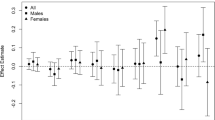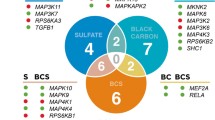Abstract
Exposure to chronic stress such as living in disadvantaged neighborhoods has been related to cardiovascular disease (CVD). Chronic stress may increase the risk for CVD by increasing levels of systemic inflammation (e.g., higher levels of pro-inflammatory cytokines). Differential DNA methylation of inflammation-related candidate genes is also related to higher risk for CVD. Thus, the purpose of this review was to examine the association of neighborhood disadvantage with DNA methylation. A search of literature was conducted using Scopus, CINAHL, PubMed, Medline, and Embase databases. The keywords neighborhood, neighborhood disorder, neighborhood crime, neighborhood violence, neighborhood safety, built environment, and housing vacancy were combined with the keywords DNA methylation and epigenetics. Five studies were included in this review (n = 3 adult blood samples and n = 2 fetal blood samples). Four of the five studies reported an association of neighborhood socioeconomic status, social environment, and crime with either global or gene-specific DNA methylation. Only two studies examined the association of neighborhood disadvantage with inflammation-related candidate genes. One of these studies found a significant association of neighborhood socioeconomic disadvantage and social environment with DNA methylation in inflammation-related candidate genes. Thus, data are limited on the association between neighborhood disadvantage and DNA methylation of inflammation-related candidate genes, as well as genes in other potential mechanistic pathways including psychosocial stress, toxin response, and adiposity. Future studies should examine these associations and the potential epigenetic mechanisms by which neighborhood disadvantage increases the risk for CVD.


Similar content being viewed by others
References
Heron M. Deaths: Leading causes for 2016, vol. 67. Hyattsville, MD: National Center for Health Statistics; 2018.
Smykiewicz P, Segiet A, Keag M, Żera T. Proinflammatory cytokines and ageing of the cardiovascular-renal system. Mech Ageing Dev. 2018;175:35–45.
Wilbur J, Braun LT, Arslanian-Engoren C, Lauver DR, Halloway S. Assessing and addressing cardiovascular risk in young women. Nurs Outlook. 2018;66(3):325–8.
Fryar CD, Chen T, Li X. Prevalence of uncontrolled risk factors for cardiovascular disease: United States, 1999–2010. NCHS data brief, no 103. Hyattsville: National Center for Health Statistics; 2012.
Kanchi R, Perlman SE, Chernov C, et al. Gender and race disparities in cardiovascular disease risk factors among New York City adults: New York City Health and Nutrition Examination Survey (NYC HANES) 2013–2014. J Urban Health. 2018;95(6):801–12. https://doi.org/10.1007/s11524-018-0287-x.
Mujahid MS, Diez Roux AV, Cooper RC, Shea S, Williams DR. Neighborhood stressors and race/ethnic differences in hypertension prevalence (the multi-ethnic study of atherosclerosis). Am J Hypertens. 2011;24(2):187–93.
Claudel SE, Adu-Brimpong J, Banks A, Ayers C, Albert MA, Das SR, et al. Association between neighborhood-level socioeconomic deprivation and incident hypertension: a longitudinal analysis of data from the Dallas heart study. Am Heart J. 2018;204:109–18.
Giurgescu C, Zenk SN, Dancy BL, Park CG, Dieber W, Block R. Relationships among neighborhood environment, racial discrimination, psychological distress, and preterm birth in African American women. JOGNN J Obstet Gynecol Neonatal Nurs. 2012;41(6):E51–61.
Giurgescu C, Misra DP, Sealy-Jefferson S, Caldwell CH, Templin TN, Slaughter- Acey JC, et al. The impact of neighborhood quality, perceived stress, and social support on depressive symptoms during pregnancy in African American women. Soc Sci Med. 2015;130:172–80.
Giurgescu C, Zenk SN, Templin TN, Engeland CG, Dancy BL, Park CG, et al. The impact of neighborhood environment, social support and avoidance coping on depressive symptoms of pregnant African American women. Womens Health Issues. 2015;25(3):294–302.
Giurgescu C, Zenk SN, Templin TN, Engeland CG, Kavanaugh K, Misra DP. The impact of neighborhood conditions and psychological distress on preterm birth in African-American women. Public Health Nurs. 2017;34:256–66.
Baghai TC, Varallo-Bedarida G, Born C, et al. Classical risk factors and inflammatory biomarkers: One of the missing biological links between cardiovascular disease and major depressive disorder. Int J Mol Sci. 2018;19(6). https://doi.org/10.3390/ijms19061740.
Vaccarino V, Wilmot K, Mheid IA, Ramadan R, Pimple P, Shah AJ, et al. Sex differences in mental stress-induced myocardial ischemia in patients with coronary heart disease. J Am Heart Assoc. 2016;5(9). https://doi.org/10.1161/JAHA.116.003630.
Cooper DC, Trivedi RB, Nelson KM, Reiber GE, Zonderman AB, Evans MK, et al. Sex differences in associations of depressive symptoms with cardiovascular risk factors and metabolic syndrome among African Americans. Cardiovasc Psychiatry Neurol. 2013;2013:1–10.
McEwen BS. Stressed or stressed out: what is the difference? J Psychiatry Neurosci. 2005;30(5):315–8.
McEwen BS. Brain on stress: how the social environment gets under the skin. Proc Natl Acad Sci U S A. 2012;109(SUPPL.2):17180–5.
Peters A, BS ME. Introduction for the allostatic load special issue. Physiol Behav. 2012;106(1):1–4.
Witek-Janusek L, Mathews HL. Stress, immunity and health outcomes. In: Stress and Coping. Virginia: Sage; 2000.
Giurgescu C, Engeland CG, Zenk SN, Kavanaugh K. Stress, inflammation and preterm birth in African American women. Newborn Infant Nurs Rev. 2013;13(4):171–7.
Elenkov IJ, Chrousos GP. Stress hormones, proinflammatory and antiinflammatory cytokines and autoimmunity. Ann N Y Acad Sci. 2002;996:290–303.
Kunz-Ebrecht SR, Mohamed-Ali V, Fledman PJ, Kirschbaum C, Steptoe A. Cortisol responses to mild psychological stress are inversely associated with proinflammatory cytokines. Brain Behav Immun. 2003;17(5):373–83.
Dowlati Y, Herrmann N, Swardfager W, Liu H, Sham L, Reim EK, et al. A meta-analysis of cytokines in major depression. Biol Psychiatry. 2010;67(5):446–57.
Liu Y, Ho RCM, Mak A. Interleukin (IL)-6, tumour necrosis factor alpha (TNF-α) and soluble interleukin-2 receptors (sIL-2R) are elevated in patients with major depressive disorder: a meta-analysis and meta-regression. J Affect Disord. 2012;139(3):230–9.
Valkanova V, Ebmeier KP, Allan CLCRP. IL-6 and depression: a systematic review and meta-analysis of longitudinal studies. J Affect Disord. 2013;150(3):736–44.
Gill J, Vythilingam M, Page GG. Low cortisol, high DHEA, and high levels of stimulated TNF-α, and IL-6 in women with PTSD. J Trauma Stress. 2008;21(6):530–9.
Michaud M, Balardy L, Moulis G, Gaudin C, Peyrot C, Vellas B, et al. Proinflammatory cytokines, aging, and age-related diseases. J Am Med Dir Assoc. 2013;14(12):877–82.
Wang NC, Matthews KA, Barinas-Mitchell EJM, Chang CCH, El Khoudary SR. Inflammatory/hemostatic biomarkers and coronary artery calcification in midlife women of African-American and white race/ethnicity: the Study of Women’s Health Across the Nation (SWAN) heart study. Menopause. 2016;23(6):653–61.
Cozier YC, Albert MA, Castro-Webb N, Coogan PF, Ridker P, Kaufman HW, et al. Neighborhood socioeconomic status in relation to serum biomarkers in the black women’s health study. J Urban Health. 2016;93(2):279–91.
Saban KL, Mathews HL, de Von HA, Janusek LW. Epigenetics and social context: implications for disparity in cardiovascular disease. Aging Dis. 2014;5(5):346–55.
Jones PA, Takai D. The role of DNA methylation in mammalian epigenetics. Science. 2001;293(5532):1068–70.
Schiattarella GG, Madonna R, Van Linthout S, et al. Epigenetic modulation of vascular diseases: assessing the evidence and exploring the opportunities. Vasc Pharmacol. 2018;107:43–52.
Fernández-Sanlés A, Sayols-Baixeras S, Subirana I, Degano IR, Elosua R. Association between DNA methylation and coronary heart disease or other atherosclerotic events: a systematic review. Atherosclerosis. 2017;263:325–33.
Smith JA, Zhao W, Wang X, Ratliff SM, Mukherjee B, Kardia SLR, et al. Neighborhood characteristics influence DNA methylation of genes involved in stress response and inflammation: the multi-ethnic study of atherosclerosis. Epigenetics. 2017;12(8):662–73.
Coker ES, Gunier R, Huen K, Holland N, Eskenazi B. DNA methylation and socioeconomic status in a Mexican-American birth cohort. Clin Epigenetics. 2018;10(1). https://doi.org/10.1186/s13148-018-0494-z.
King KE, Kane JB, Scarbrough P, Hoyo C, Murphy SK. Neighborhood and family environment of expectant mothers may influence prenatal programming of adult cancer risk: discussion and an illustrative DNA methylation example. Biodemography Soc Biol. 2016;62(1):87–104.
Janusek LW, Tell D, Gaylord-Harden N, Mathews HL. Relationship of childhood adversity and neighborhood violence to a proinflammatory phenotype in emerging adult African American men: an epigenetic link. Brain Behav Immun. 2017;60:126–35.
Lei MK, Beach SRH, Simons RL, Philibert RA. Neighborhood crime and depressive symptoms among African American women: genetic moderation and epigenetic mediation of effects. Soc Sci Med. 2015;146:120–8.
Quinn JP, Savage AL, Bubb VJ. Non-coding genetic variation shaping mental health. Curr Opin Psychol. 2019;27:18–24.
Garfield L, Mathews HL, Inflammatory JLW. Epigenetic pathways for perinatal depression. Biol Res Nurs. 2015;18(3):331–43.
Mathews HL, Janusek LW. Epigenetics and psychoneuroimmunology: mechanisms and models. Brain Behav Immun. 2011;25(1):25–39.
Laraia BA, Messer L, Kaufman JS, Dole N, Caughy M, O'Campo P, et al. Direct observation of neighborhood attributes in an urban area of the US south: characterizing the social context of pregnancy. Int J Health Geogr. 2006;5:11.
Giurgescu C. The Impact of Uncertainty, Social Support, and Prenatal Coping on the Psychological Well-Being of Women with High-Risk Pregnancy. Chicago: Loyola University of Chicago; 2004.
Mustillo S, Krieger N, Gunderson EP, Sidney S, McCreath H, Kiefe CI. Self-reported experiences of racial discrimination and black-white differences in preterm and low-birthweight deliveries: the CARDIA study. Am J Public Health. 2004;94(12):2125–31.
Holzman C, Eyster J, Tiedje LB, Roman LA, Seagull E, Rahbar MH. A life course perspective on depressive symptoms in mid-pregnancy. Matern Child Health J. 2006;10(2):127–38.
Seng JS, Kohn-Wood LP, McPherson MD, Sperlich M. Disparity in posttraumatic stress disorder diagnosis among African American pregnant women. Arch Womens Ment Health. 2011;14(4):295–306.
Warnecke RB, Oh A, Breen N, Gehlert S, Paskett E, Tucker KL, et al. Approaching health disparities from a population perspective: the National Institutes of Health Centers for Population Health and Health Disparities. Am J Public Health. 2008;98(9):1608–15.
Acknowledgments
There was no funding for this review article.
Author information
Authors and Affiliations
Corresponding author
Additional information
Publisher’s Note
Springer Nature remains neutral with regard to jurisdictional claims in published maps and institutional affiliations.
Rights and permissions
About this article
Cite this article
Giurgescu, C., Nowak, A.L., Gillespie, S. et al. Neighborhood Environment and DNA Methylation: Implications for Cardiovascular Disease Risk. J Urban Health 96 (Suppl 1), 23–34 (2019). https://doi.org/10.1007/s11524-018-00341-1
Published:
Issue Date:
DOI: https://doi.org/10.1007/s11524-018-00341-1




